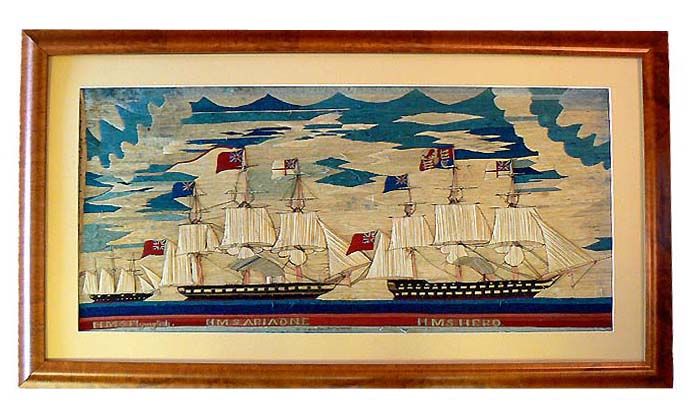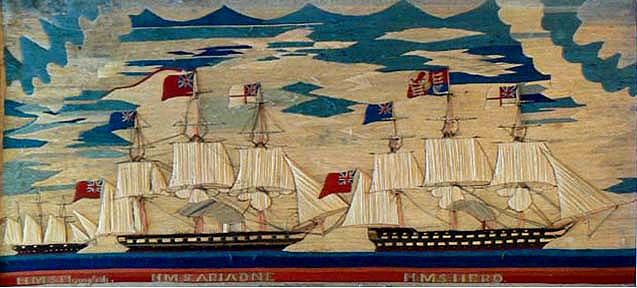niece

Viewing area 38 3/4″ x 181/4″
Framed 48″ x 28″
Stitched on canvas
Date Ca 1857 -1862
Presentedis a magnificently made woolie of three well documented
British warships which all served together in the British Channel Squadron during the period 1859 – 1862.
In
alphabetical order, the ships were the HMS Ariadne, a steam frigate launched in June, 1859. She was 280 feet long,
4583 tons displacement and carried 450 men and 26 guns. HMS Flying Fish, a small gun vessel was launched
in December, 1855 of 6 guns and 871 displacement tons. HMS Hero was launched in April, 1858 as a
two deck screw propelled 2nd rater of 234 feet in length and 4765 tons displacement. She carried a crew of 860 and 91
guns. The woolie was said to have been made by a crew member of the Ariadne, and possibly hung in her wardroom. The stitching
is some of the finest we have seen and intricately worked in different directions using different types of stitches to show a
complex treatment of the sky. The rigging was done in extensive detail, but much of it has been lost over the intervening
years. The British frequently assign a name they like to various ships more than once, but from
what we know, the ships listed are the most likely vessels portrayed in the wool work. The Royal Standard
is flying from HMS Hero’s main truck. Woolies that have the ship’s name which can be dated
are extremely important and rare. This one is especially important because of its larger size, ships’ history and brilliant
colors and unusual provenance.
PROVENANCE:
It was brought back to the States
from London around 1922 by silent film star Norma Talmadge, the most famous actress of her day, who had it until
she gave it to her niece Barbra Talmadge in 1946. It has been in Barbara’s possession ever since. Full documentation
including a letter of authenticity and family photos will accompany the artwork. There is an abundance of film industry history here since sister
Natalie Talmadge, her niece Barbara’s mother was married to Buster Keaton and made two films with him, and worked for Fatty
Arbuckle. Norma’s second husband was George Jessel. Norma’s first husband was Joe Schenck, head of one of the earliest
silent film companies who gave Buster his start. SCROLL DOWN TO SEE FAMILY
PICTURES IN GALLERY BELOW Norma Talmage the leading silent film star of the 1920’s Natalie and Buster’s
wedding from left to right, Norma, Buster, Natalie, and Constance. Buster Keaton and Natalie Talmadge
CONDITION: The wool work has been recently reframed
because the original frame was larger than the stretcher and contributed to the woolies’ wear. There are grooves
in the back of the stretcher from the nail heads when it slid back and for forth, also up and down. We believe the rolling
and pitching of a ship are the only forces that would do that. The mat serves to hide the irregularities of the border. On
the left side, the canvas is pulled to the right due to shrinking. The mat was cut on that side to include the red ensign
of the Flying Fish, and to show the stretching. The woolie is worked in shades of blue, tan, black, cream,
white and red and with the colors still brilliant. There is broken yarn and much of the ships standing
and running rigging has been lost with age. There also is some spotting. However, from a foot or two away, all that becomes
secondary to its brilliant colors and complexity of design and embroidery.BRITISH NATIONAL FLAGS: Don’t be confused by her RED ENSIGNS
which are flying from the mizzen gaffs. Today they are used by the British Merchant Navy, but not then. This
flag was originally introduced in the early 17th Century for use aboard ships and land and was the flag flown during
the time of the American Revolution. At sea, the Red Ensign was originally the principal ensign of the Royal Navy, and
as such it was worn by ships of the Red Squadron, as well as by those warships that were not assigned to a squadron. The
white and the blue ensign were used to designate the other two squadrons. In July 1864, the White Ensign
became the standard of the Royal Naval Service. The Blue Ensign became the national colours of ships commanded
by an officer of the Royal Naval Reserve, and with appropriate badges added as national colours for ships in government service of
the Commonwealth countries. The Red Ensign was assigned to British merchantmen. This structure remains today.HISTORY of WOOLIES: British sailors crafting woollies were talented
needle workers. The height of popularity of this form of folk-art was between 1840-1880. The sailors learned their craft through
their daily routines of repairing the ship’s sails and taking care of their uniforms. They made the most of their limited
spare time and personal space by creating works of art that could be rolled up ,, and stored under their bunks when not being
worked on. These sailors were knowledgeable about their ships and their surroundings and were skilled at drawing on canvas
and then transforming a simple sketch into a vibrant, detailed, and interesting ship picture. Their accomplishments is magnified
by being self taught and creating their works for the satisfaction they gave since there was no profit motive. The overwhelming
majority of woollies are unsigned. A woollies recent sale of such a wool work brought $22,000.00 in Massachusetts and they
regularly sell for in the twenty thousand dollars.A SIMPLE CHECK LIST FOR BUYING WOOLIES Condition is probably the most important
consideration. Are the threads intact, are they stretched, water stained, moth eaten, etc. Expect to see some fading
of color which is a good indication of age. The most highly sought after, and therefore the most valuable, are
those that are identifiable as a specific vessel. Color: Bright vibrant colors may be the
sign of a recently made piece, but it also could be that of one that was stored away or out of the sunlight which would be
a good thing. Complexity of design:Woolies that have
more than a simple profile of a ship are more valuable. Some have land in the background, the name of the vessel, various
flags flying, crests or other embellishments that add value. Design: Some sailors had a knack for composition
and color sense which make the work visually appealing while others ended with an unattractive scene.Size:The larger the size, the higher the value. Most are about 16 x 24 inches. Stitching: There are various stitches that
sailors used many of which came from sail making, but others learned the art of embroidery so they combined complex stitches
for detailing. This adds value. Long stitches take less time, and therefore closely spaced stitches add to the value.If nothing else, remember HISTORIC SIGNIFICANCE, CONDITION, COMPOSITION, COMPLEXITY enhance value

